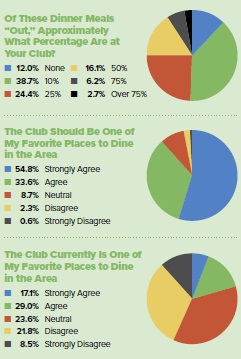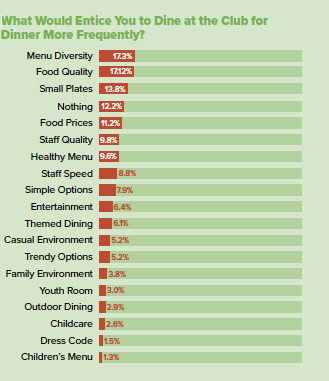
Of all the factors that contribute to member satisfaction, dining is the most important, because it is the most universal in its appeal and use. While not everyone uses other recreational facilities and amenities offered by a club, arguably everyone who is part of a member family, from oldest to youngest and of all genders, will at some point partake of at least one aspect of the club’s food-and-beverage program, be it just a snack bar or beverage cart purchase or a full dining room meal.
While dining is the most important factor in member satisfaction, it is also the most challenging to get right. This has been borne out consistently by more than 1,600 member satisfaction surveys McMahon Group has conducted.
The surveys gauge satisfaction with all aspects of a club’s operation on a five-point scale, with five representing “very satisfied” and one representing “very dissatisfied.” The goal in all cases is to achieve satisfaction ratings of 4.0 or higher, and to keep levels of dissatisfaction no higher than 10%.
While many clubs’ surveys yield responses that reach and surpass those goals for golf, tennis, fitness and other offerings, dining is the area that most often falls short. In many cases, ratings for dining drag overall member satisfaction (and elevate dissatisfaction) to unacceptable levels and pinpoint the primary reason a club may be having difficulties retaining existing members and attracting new ones.
McMahon Group’s Private Club Member Survey Database shows that more than 70% of clubs surveyed have dining program deficiencies, and that while an overwhelming majority of members say their club should be one of their favorite everyday places to dine, fewer than half say it actually is.
The charts and tables accompanying this article illustrate the key dining-related benchmarks reflected by the survey database and highlight the shortfalls that

currently exist between member expectations and industry-wide averages for what is currently being delivered:
- Dining ranks as a very important or important factor for 92.3% of all members, with even higher percentages for subsets that are critical for continuing to attract and stay relevant for the next generation of membership: members under age 46 (94%); members who joined the club within the last six years (93.2%); members with children younger than 18 (93.9%) and female respondents (95%).
- Dining was ranked as a very important or important reason for joining their club by 84.3% of survey respondents, and as unimportant or very unimportant by only 4%.
- The current satisfaction level with club dining is only 69.7% (or 3.67 on the five-
- point scale) among respondents, with less than a quarter (24.5%) saying they were very satisfied. Additionally, 11% of all respondents said they were dissatisfied and another 3.3% said they were very dissatisfied.

- Club members are very active restaurant-goers, with more than half of respondents saying they dine out for dinner at least eight times a month on average, and 6% saying they dine out more than 20 times a month. Only 11.4% say they dine out for dinner fewer than four times a month.
- More than half of respondents, however, say they choose their club as their dinner destination only 10% or less of the time, with 12% saying the club is never their choice.
- Responses to survey questions about whether the club should be one of members’ favorite places to dine, and whether it actually is, also show a concerning disconnect. While more than half (54.8%) of respondents strongly agree their club should be one of their favorite places to dine and another 33.6% agree, less than half (46.1%) either agree or strongly agree that is actually the case, with nearly 30% disagreeing or strongly disagreeing.
- When asked if they are satisfied with specific aspects of their club dining program, only staff friendliness (57.2%) has sustained approval from a majority of the survey database, with 18 other factors, ranging from staff appearance (44.5%) to days dining is offered (15.0%), all falling short.
- The survey database also reflects support for a variety of choices when answering the question, “What would entice you to dine at the club for dinner more frequently?” These range from greater menu diversity and food quality to offering more outdoor dining, providing childcare services and a children’s menu, and changing the dress code.


